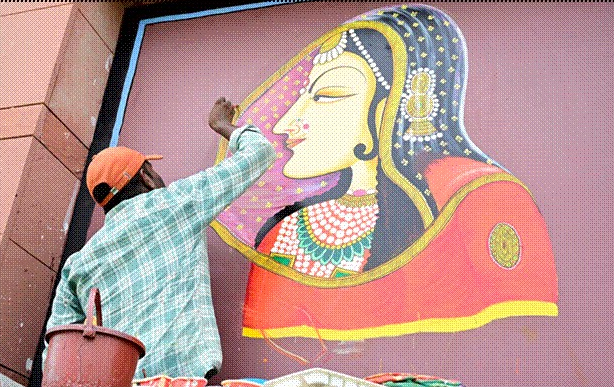Project PARI (Public Art of India) (GS Paper 2, Government Policies)

Overview:
- Initiated by: Ministry of Culture
- Event: 46th Session of the World Heritage Committee Meeting, New Delhi
- Objective: Project PARI aims to bring public art inspired by India's rich artistic heritage (lok kala/lok sanskriti) into public spaces. The project seeks to integrate traditional art forms with modern themes and techniques to beautify and culturally enrich urban areas.
Details:
- Artists Involved: More than 150 visual artists from different regions of India.
- Artworks: The project will include various forms of art such as wall paintings, murals, sculptures, and installations.
- Locations: These artworks will be installed in various public spaces across Delhi, transforming the city into a vibrant and culturally immersive environment.
Themes of Sculptures and Artworks:
- Tribute to Nature: Sculptures and installations celebrating the beauty and importance of the natural world.
- Ideas from the Natyashastra: Art inspired by the ancient Indian treatise on the performing arts, encompassing drama, dance, and music.
- Gandhi: Artworks paying homage to Mahatma Gandhi, reflecting his ideals and legacy.
- Toys of India: Sculptures and installations inspired by traditional Indian toys, showcasing the country's cultural heritage and craftsmanship.
- Ancient Knowledge: Art reflecting India's vast repository of ancient knowledge, including science, mathematics, astronomy, and philosophy.
- Naad (Primeval Sound): Art exploring the concept of sound and its spiritual significance in Indian culture.
- Harmony of Life: Installations and sculptures symbolizing the balance and interconnectedness of life.
- Kalpataru (Divine Tree): Art inspired by the mythical wish-fulfilling tree in Indian mythology, symbolizing prosperity and abundance.
World Heritage Committee (WHC)
- Role: The WHC is responsible for the inscription of new sites into the UNESCO World Heritage List, which recognizes and protects sites of outstanding cultural or natural importance to humanity.
- 2024 Meeting: For the first time, India will host the World Heritage Committee Meeting in July 2024.
- India's UNESCO World Heritage Sites:
- Total Sites: 42
- Categories:
-
- Cultural: 34 sites (e.g., Taj Mahal, Qutub Minar)
- Natural: 7 sites (e.g., Kaziranga National Park, Sundarbans)
- Mixed: 1 site (Khangchendzonga National Park)
- Recent Addition: Sacred Ensembles of the Hoysala, renowned for their intricate temple architecture and cultural significance.
Significance of Project PARI and the WHC Meeting
Cultural Impact:
- Revitalizing Public Spaces: Project PARI aims to transform Delhi’s public spaces into dynamic cultural hubs, making art accessible to everyone and fostering a deeper connection between people and their cultural heritage.
- Promotion of Indian Art: By integrating traditional and modern art forms, the project promotes India's diverse artistic traditions and encourages contemporary interpretations.
Economic and Tourism Benefits:
- Attracting Tourists: The beautification of public spaces with culturally rich artworks can attract tourists, boosting local economies.
- Global Recognition: Hosting the WHC Meeting enhances India’s global standing in heritage conservation and cultural promotion, potentially attracting international investment and collaboration.
Educational and Social Impact:
- Cultural Education: The artworks serve as educational tools, raising awareness about India's rich cultural heritage among residents and visitors.
- Community Engagement: Involving local artists and communities in the creation and installation of art fosters a sense of pride and ownership, encouraging community engagement and participation in cultural activities.
Challenges and Future Directions:
- Maintenance and Preservation: Ensuring the long-term maintenance and preservation of public artworks is crucial for sustaining their impact.
- Expanding Initiatives: Building on the success of Project PARI, similar initiatives could be launched in other cities across India, promoting cultural integration and urban beautification nationwide.
Conclusion:
- Project PARI and the hosting of the World Heritage Committee Meeting represent significant steps towards celebrating and preserving India’s cultural heritage.
- These initiatives highlight the importance of public art in enriching urban spaces, fostering cultural appreciation, and promoting India’s artistic legacy on a global stage.
- Through such efforts, India can strengthen its cultural identity, attract global attention, and inspire future generations to value and protect their heritage.


